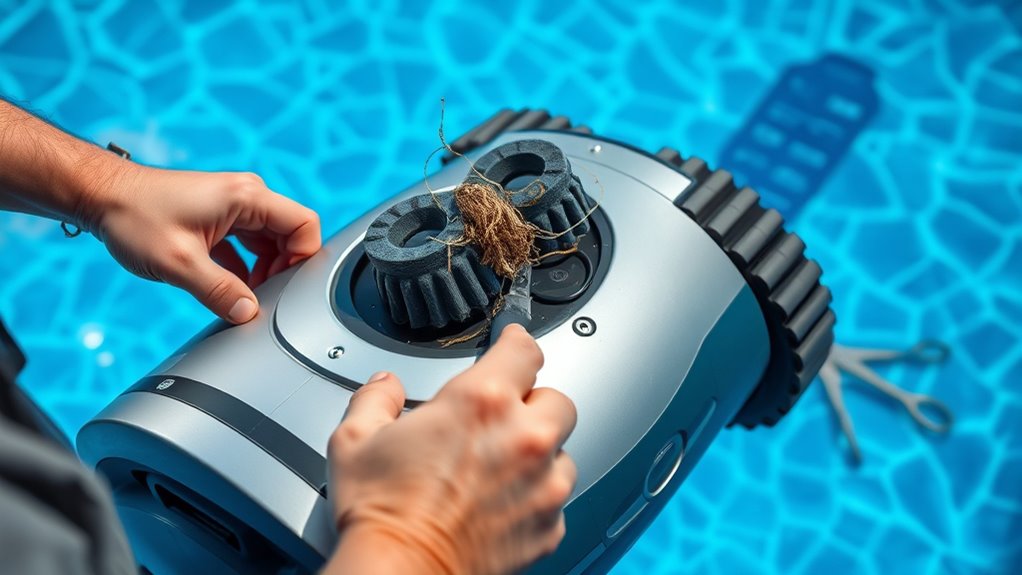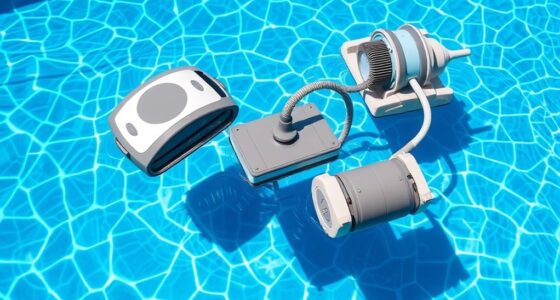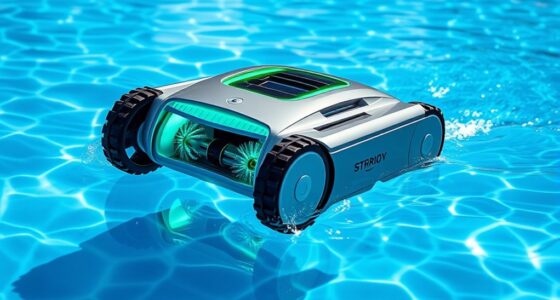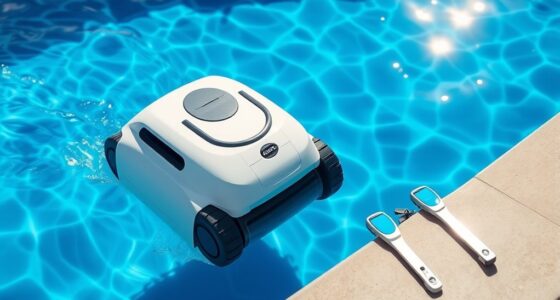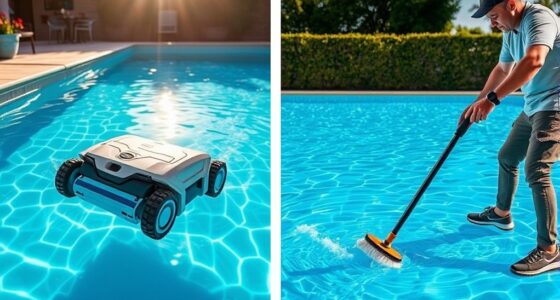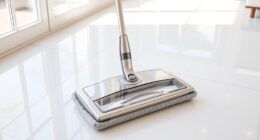To replace worn parts on your robotic pool cleaner, start by inspecting the brushes, track wheels, and filters regularly for signs of damage or wear. Remove any damaged or frayed brushes, cracked track wheels, and clogged filters, then follow the manufacturer’s instructions to install new parts. Keeping these components in good condition guarantees efficient cleaning and longer device life. If you want to learn detailed steps, there’s more to explore to keep your cleaner running smoothly.
Key Takeaways
- Regularly inspect brushes, track wheels, and filters for signs of wear or damage before replacing.
- Remove worn parts carefully following the manufacturer’s instructions to avoid damage.
- Replace brushes, track wheels, and filters promptly when they show signs of deterioration or reduced performance.
- Ensure new parts are compatible with your specific robotic pool cleaner model for proper fit and function.
- Perform routine maintenance, such as cleaning filters and checking connections, to prolong the lifespan of new parts.
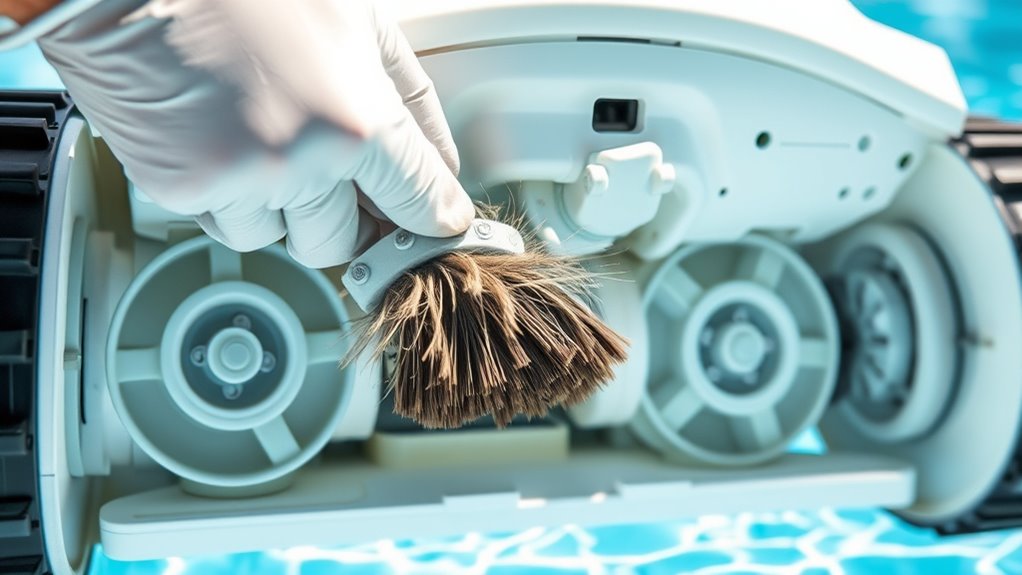
Over time, the wear and tear on your robotic pool cleaner’s parts can reduce its efficiency and cleaning power. When your cleaner isn’t performing as well as it used to, it’s often a sign that some components need replacing. Staying proactive with maintenance tips can help you extend the life of your device and guarantee it continues to keep your pool spotless. Regularly inspecting brushes, tracks, and filters allows you to spot worn parts early, preventing bigger problems down the line. If you notice your cleaner missing spots or getting stuck more frequently, troubleshooting issues quickly can save you time and money. Sometimes, the solution is as simple as replacing a worn brush or cleaning a clogged filter, but other times, a more detailed inspection is necessary. To stay ahead of potential failures, understanding the importance of robotics integration in your pool cleaner can help you recognize when advanced features are no longer functioning optimally. Additionally, familiarizing yourself with available replacement parts can streamline repairs and reduce downtime. Checking the wear points regularly ensures you catch issues before they escalate, maintaining optimal performance. To start, familiarize yourself with the common parts that wear out first—brushes, track wheels, and filters. Brushes tend to fray or become less effective at scrubbing dirt from the pool surface, especially if they’re old or damaged. Replacing them is straightforward: remove the old brushes according to your model’s manual and snap in new ones. Track wheels can become cracked or lose traction, causing the cleaner to get stuck or move inefficiently. Check their condition regularly, and if they’re worn or broken, swap them out promptly. Filters, on the other hand, trap debris and prevent clogs. A dirty or clogged filter reduces suction power, so cleaning or replacing it can restore top performance. Performing routine maintenance on these components can significantly extend your cleaner’s lifespan and keep it operating efficiently. Moreover, keeping an eye on manufacturer recommendations can help you follow the best practices for your specific model and avoid unnecessary repairs. Troubleshooting issues is part of maintaining your robotic pool cleaner. If it’s not moving properly or skipping areas, examine the tracks and wheels for debris or damage. Sometimes, tangled cords or obstructions can cause operational hiccups, so clear those out. If your cleaner isn’t cleaning thoroughly or leaves dirt behind, inspect the brushes and filters. Regular maintenance tips include thoroughly rinsing filters, replacing worn parts, and checking for any loose connections. Keeping these components in excellent condition ensures your cleaner works efficiently and prevents costly repairs.
Frequently Asked Questions
How Often Should I Inspect My Robotic Pool Cleaner for Wear?
You should follow an inspection schedule of every 2 to 4 weeks to keep your robotic pool cleaner in top shape. Keep an eye on wear indicators like frayed brushes or cracked wheels, which signal it’s time for maintenance. Regular inspections help you catch issues early, ensuring your cleaner works efficiently and lasts longer. Don’t wait until it breaks down—consistent checks save you time and money in the long run.
Can I Replace Parts Myself or Need Professional Help?
Think of your robotic pool cleaner as a trusty steed needing some care. You can often handle DIY repair if you’re comfortable with basic tools and follow instructions carefully. However, for complex issues or if you’re unsure, it’s wise to seek professional assistance. This way, you guarantee your cleaner stays in top shape, avoiding further damage, and keeps your pool sparkling clean without risk.
Are There Compatible Brands for Replacement Parts?
You might wonder if there are compatible brands for replacement parts. It’s important to check brand compatibility because not all parts are interchangeable across different brands or models. Many manufacturers design their parts with specific fit and function in mind, so using the right brand guarantees proper performance. Always verify part interchangeability and compatibility before purchasing to avoid issues, and consider sticking to original or recommended brands for the best results.
What Are Signs That a Part Needs Replacing Before Failure?
It’s easy to ignore signs your pool cleaner needs help, but catching wear indicators early can save you money and frustration. Look for decreased cleaning performance, strange noises, or irregular movement—these are early warning signs. Pay attention to belt fraying or cracked brushes, which signal that a part is wearing out. Addressing these signs promptly prevents complete failure and keeps your pool sparkling, making maintenance less stressful and more effective.
How Do I Dispose of Old or Damaged Robotic Pool Parts?
When disposing of old or damaged robotic pool parts, you should follow proper disposal methods to safeguard the environment. Check if recycling options are available in your area; many electronic or plastic parts can be recycled. If recycling isn’t an option, dispose of the parts at designated electronic waste collection centers. Always avoid throwing these parts in regular trash to prevent pollution and ensure responsible waste management.
Conclusion
Replacing worn parts on your robotic pool cleaner keeps it running smoothly and extends its lifespan. Did you know that regular maintenance can increase your cleaner’s efficiency by up to 30%? By staying on top of part replacements, you not only save money on repairs but also enjoy a cleaner pool with less effort. So, take a little time now—your pool will thank you, and you’ll enjoy crystal-clear water all season long.
